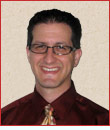| Schedules: Tools for Success |
 Jarrod Shapiro, DPM
PRESENT Practice Perfect Editor
Jarrod Shapiro, DPM
PRESENT Practice Perfect Editor
Mountain View
Medical &
Surgical Associates,
Madras, Oregon |
he devil is in the details. This seems no truer than in a physician’s daily schedule. When running a practice, there are so many miniscule, mundane, yet critical details that seem to make or break a practice. Take, for example, Medicare forms. There seems to be no more boring, arduous task than filling out these voluminous forms. The smallest detail omitted will lead to delays, more paperwork, and lack of reimbursement. What about other details that appear, at first glance, to be unimportant but in practice, become highly significant? The physician’s schedule tops this list.
For those of you in residency or fellowship, you may think this is a no-brainer. You argue, "Why worry about my schedule? I'll work as hard as possible to build a practice and maintain a full schedule." I'd argue, in return, that your schedule requires more planning than you realize.
| Think about these factors: |
|
- How much staffing do you need based on patient volume and your schedule?
- How many patients can you see in a day and still provide quality care?
- How long do you want to spend with new patients?
- How long do you want to spend with returning patients?
- How long do you need for preops and postops?
- Do you want to schedule days with extended or late hours?
- When do you want to start and stop seeing patients in a given day?
- Do you want to have Saturday hours?
- Will you have block surgical time or not?
- If you own your practice, do you need administrative time?
- How much support will you have from your staff? I.e. how much work do you have to do yourself per patient?
- How much personal/family time would you like to have?
|
|
Practice Perfect now features brand new lectures on podiatry.com – viewable for CME Credit.
Take advantage of our limited-time 20/20 Offer, where you can get CME Credit for FREE.
Details are provided at the conclusion of the eZine. |
|
|
It’s no longer quite so simple, is it?
I think it all boils down to preparation and efficiency. If you like to fly by the seat of your pants, then by all means, disregard the above considerations. If you prefer smoothness and a sense of professionalism in your practice, then I’d recommend considering some of the above factors.
Here’s what I would view as an ideal model for my schedule. This is only one method; many exist based on what the doctor’s needs may be. As a small disclaimer, the schedule below is NOT my actual schedule. As an employee of a larger organization, I have some limitations over the control of my schedule.
An Idealized Office Schedule
The basic patient schedule is 9 AM – 4 PM Monday, Wednesday, and Thursday, 8 AM – 12 PM Friday (administrative/personal time Friday afternoon) and Saturday. Tuesday elective surgery (which allows for a 3 day first postop visit). Non-elective surgery scheduled as needed. One of these days would start early (7:30AM) and one would end late (6PM) to accommodate working folks and children in school. Saturday, as I’m told by several long-practicing physicians, is a good day for working patients and is usually busy. Optimally, the time allotted for each patient visit would vary based on the complexity of the visit. For doctors just starting out, I’d recommend giving your new patients 30 minutes. Patients love when their doctor can spend extra time with them. Follow-up visits would vary also, with simple visits (ex. warts, palliative care) having shorter visits than complex visits (ex. wounds or complex orthopedic issues). I give preoperative visits about 20 minutes, because I spend a lot of extra time on a formal consent process. Uncomplicated postop visits, on the other hand, usually require no more than 10 minutes.
Again, these times depend on how much support you have from staff. A simple first postoperative bunionectomy visit with staff redressing the foot, for instance, would require less than 5 minutes of your time.
A recommendation I’ve found to be highly useful in practice is to avoid scheduling new patients as the first or last patient of the day or just before lunch. A new patient always has a chance to be more complex and time consuming than you originally thought. This method will prevent unnecessary backups and delays.
With some forethought and planning, the schedule can be a tool to make a physicians life more efficient, organized, and less stressful. Good luck with your schedule plans.
Keep writing in with your thoughts and comments or visit eTalk on PRESENT Podiatry and start or get in on the discussion. We'll see you next week. Best wishes!

Jarrod Shapiro, DPM
PRESENT New Docs Editor
[email protected]
|